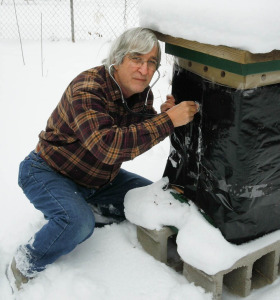I have 16 inches of blown-in insulation over 4 inches of batting in my house. The walls are insulated, along with new windows and doors, as well as a high efficiency furnace. It’s cozy. And so are the bee colonies that live in old trees, they have 8 to 10 inches of wood insulation on the sides and many feet on the top and bottom of the hive.
But what about my back yard bee hives? All they have is a half inch of wood for insulation. Not cozy! Yes they say it’s moisture not cold that kills bees. But if they have to eat more stores to keep warm, it takes its toll. So why not insulate your hives?
I use a special hive body. It has a screened bottom , screened over side holes and an open top. You place it on the top of the hive and fill it with hamster bedding. Then cover with the inner and outer cover. I call it the ‘attic’. This both insulates the major heat loss area and allows for ventilation. Yes you can leave it on year around.
These ‘attics’ are available from the big suppliers as well as local ones. I like the ones from Buggs Nest West (Galesburg, MI) (see the resource/equipment page). They have full screen bottoms. The ones with small holes get propolized.
As for the sides, I use 2″ thick Foamular R-10 ridge pink insulation. It comes in 4×8 sheets and easy to cut with a hand saw. A little pricy, around $35 a sheet, but should do two hives and last for years. 6′ bungee cords hold it on. If you don’t like pink, spray it green or your favorite color. Make sure it does not cover the entrance or the ‘attic’ vent holes.
Add to this your slide-in bottom board, if yours is not solid, and the entrance reducer. Feed if you like (that’s another blog, stay tuned).
One more tip. Want to see if your hive is alive in mid-winter?. Get out that old stethoscope, and bang on the hive. Hope you hear angry bees. If you’re lucky some guards will come out and chase you back to the cozy fire place.

Thank you for the info Tom, nice picture’s too.
Hi Tom, I put an inner cover on my bee houses then the moisture box under the top cover.
The top cover, covers all air holes. Should they be covered?
Any pictures or directions would appreciated.
We are suppose to have a 48 degree day this week-end. If I need to change things, this
may be my only chance this year.
My phone # is 269-870-5542.
Thanks, Ed
Hi Ed
I’ve put the shaving box on the top hive box and then put the inner cover on top of the shavings box, thus leaving more of the holes open. Usually there is at least 1/4 inch or so between the cover and the hive body or in this case the shavings box so you will still have ventilation. I left one of the shavings tops on all summer and didn’t seem to have any moisture problems, the only thing I noticed on this hive is that the bee’s did propolize some of the screen, probably less than 10% of the area.
The ideal is to have the side holes on the insulation box uncovered. However if the top cover goes over the holes there is still enough room for ventilation as top covers are normally quite loose. The best solution is to buy insulation boxes with sides high enough so the top cover does not block the side holes. But you can put a spacer box on top of the upper most brood box. These are boxes with two inch high sides. This and the inner cover should raise the top cover high enough to allow free ventilation of the side holes.
These spacers are often used for feeding pollen patties. They go on top of a brood box and hold the patties, giving the bees room to eat the patty.
See: http://www.dadant.com/catalog/product_info.php?products_id=780
What I have done is leave the inner cover on the top most brood chamber box, under my top feeder. When I take off the feeder I add the insulation box right on top of the inner cover. Even though the top cover now goes over the insulation box side holes. The inner cover has a big hole in the center to provide ventilation. I did this because I was using a top feeder. It was late in the season so when I took the top feeder off I could take it off and still leave the inner cover on, so the bees would not get chilled. But this is not the best solution.
Lastly buy insulation boxes that have screen covering the entire bottom. They provide more air flow then the ones with a screen covered hole in the bottom.